Kris Oldland, Editor-in-Chief, Field Service News reflects on the alignment of digital transformation and servitization - the two key trends driving innovation and evolution in our industry...
ARCHIVE FOR THE ‘digital-transformation’ CATEGORY
Dec 01, 2021 • Features • Digital Transformation • IFS • Sarah Nicastro • SimPRO • durabook • Servitization and Advanced Services • Iwi Lin • Ricky Sevta
Kris Oldland, Editor-in-Chief, Field Service News reflects on the alignment of digital transformation and servitization - the two key trends driving innovation and evolution in our industry...
There have been two key trends that have been consistently present within our industry for a number of years. Both have been at the heart of discussions in boardrooms and on conference stages alike. Implementation of both has been accelerated by the pandemic. These two trends are of course Digital Transformation and Servitization - but just how closely related are they?
For Sarah Nicastro, Vice President of Customer Advocacy, IFS the two are very closely aligned.
"We believe that Servitization and Digital Transformation are inextricably linked, in that the progression of digital is a major factor in the increased demands customers have that are prompting companies to Servitize as well as in the fact that it’s impossible to Servitize without digital capabilities," Nicastro explains.
"To seize the potential of advanced services, companies must view Digital Transformation as key to success. Digital is required to gain insights into the performance of assets in a way that allows a proactive and predictive response, to optimize the utilization of both its workforce and inventory in the manner necessary for guaranteeing outcomes, and to ensure the customer experience is seamless and informed.
"Data is also proving to be an integral part of an advanced services value proposition in the form of providing customers unique insights gleaned from digital tools in use. As such, companies should seek a modern digital platform that provides a range of capabilities to eliminate the failure points common in a disjointed environment and to protect the integrity of the customer experience. " she adds.
This is a comment that is echoed by Iwi Lin, Marketing Manager, Durabook.
"Digital transformation is already happening within the business-to-business sector, meaning organizations across every industry need to embrace this digital change," he comments.
"Servitization can only be a consistent and reliable revenue source if your business performance remains equally efficient and dependable..."
- Iwi Lin, Durabook.
"The adoption of emerging technology is where true industry revolution occurs, determining who will rise to the top and who will fail over time. Companies that implement technology to streamline processes, optimize budgets and improve overall workforce performance are predicted to outlast their competition.
"However, servitization can only be a consistent and reliable revenue source if your business performance remains equally efficient and dependable, which is where rugged devices come into play. These computers are fast becoming the focal point of these technologies as they enable organizations to realize even greater operational capabilities,"
Indeed, our world both inside and beyond field service is evolving rapidly in terms of technology and as we add the further pressures of a servitized business model into what is an already complex mix of many moving parts that constitute field service then the importance of being able to leverage, but also importantly trust the technologies we deploy throughout digital transformation is critical.
As Lin adds "With technological evolutions in IoT, 5G, Augmented Reality (AR), machine learning and AI, companies investing in new technologies will be able to predict and prevent operational failure. Computer manufacturers that provide rugged devices can help organizations understand how to operate these devices in the field to enable their digital transformation programs and ensure new technologies are used for their maximum benefit.
"With uninterrupted servitization a crucial factor for business success, the latest equipment is designed with optimum efficiency in mind. Rugged devices are the only models that can withstand the frequently harsh conditions many field computers must endure.
"The latest devices also contain sensors that feed operational data back to the manufacturer on the product’s condition, reducing maintenance issues and downtime. Should a problem arise, the manufacturer or service provider will be automatically notified by the faulty part so it can be quickly fixed. While they may require a greater initial outlay, they are far more cost-effective in the long term because of this lower need for maintenance costs."
"Servitization at its core means providing outcomes rather than products or even services – it’s a company-wide transformation in the identity of the business and the customer value proposition."
- Sarah Nicastro, IFS
Coming from an industry where reliability in the field is a critical component of the success of their products, Lin's point raises an important distinction between servitization and digital transformation. While they are invariably two facets of the same conversation, the latter is the enabler, while the former represents the true paradigm shift.
As Nicastro explains, "Servitization at its core means providing outcomes rather than products or even services – it’s a company-wide transformation in the identity of the business and the customer value proposition, not a simple addition to the service portfolio.
"However, in many cases this transition occurs over time in a phased manner to ease the impact on culture and operations and to help manage change."
Of course, while technological innovation or advances in service design thinking are important, these all become something of a moot point if they are not aligned with what our customers actually need and want. This is a critical part of the discussion which cannot be overlooked.
"Without customers, nothing happens," states Ricky Sevta, CRO, simPRO bluntly.
"Customers we’ve talked with agree. They also know it’s a tricky balance, tailoring your services to the unique needs of your customer while also providing high-quality service to every customer. You also have to do it better and faster than your competitors, and still turn a profit.
"In our experience working with all types of trades businesses, we believe technology like job management software, can help you do it all.
"Job management software helps you better manage all the moving parts in your business, and gives you insights (data) into how well you're truly performing in each area of your business. More importantly, it shows the relationship between these areas.
"You can then pinpoint how your performance, in these areas, good or bad, ultimately impacts the customer experience," Sevta adds.
"Your customers make everything happen. Why make them wait?'
- Ricky Sevta, simPRO
"For example, how does proper stock management impact customer service? Say your field staff arrive at a job only to realize that they don’t have what they need. Now they’re wasting the customer’s time and their time. This can lead to an irritated customer and a job that takes much longer than it needs to.
"Your engineers are set up for success, and empowered to provide good customer service when they know that they have the right materials for every job, and can check stock from anywhere at any time, but so is the rest of the team. With field management software, your admin team can check inventory while talking to a customer rather than having to take their number down, manually check the stock and then call them back."
"Your customers make everything happen. Why make them wait? Job management software, especially cloud-based software, gives staff all of the relevant information they need to deliver the best customer service no matter whether they're remote or on-site," Sevta concludes.
Indeed, there is a broad mix of tools available for field service companies of all shapes and sizes, across all sectors in today's market. Digital transformation is all around us and will continue to evolve at pace. As to will the servitization movement, with service portfolios becoming more advanced and sophisticated as we embrace such tools.
However, as Sevta rightly states, keeping the customer centre to all we do is the one true key to success.
Further Reading:
- Read more about Digital Transformation @ www.fieldservicenews.com/digital-transformation
- Read more about Servitization and Advanced Services @ www.fieldservicenews.com/blog/tag/servitization-and-advanced-services
- Read more about IFS @ www.ifs.com/
- Read more about Durabook @ www.durabook.com/
- Read more about simPRO @ www.simprogroup.com
Dec 01, 2021 • Features • connectivity • Digital Transformation • GLOBAL • TELENOR CONNEXION • LTE-M • NB-IOT
In this final feature of a series of excerpts from a recent white paper published by Telenor Connexion, we look in detail at the difference between LTE-M and NB-IOT, as a guide to make the optimal choice for your business.
In this final feature of a series of excerpts from a recent white paper published by Telenor Connexion, we look in detail at the difference between LTE-M and NB-IOT, as a guide to make the optimal choice for your business.

This feature is just one short excerpt from a white paper published by Telenor Connexion.
www.fieldservicenews.com subscribers can read the full white paper now by hitting the button below.
If you are yet to subscribe you can do so for free by hitting the button and registering for our complimentary subscription tier FSN Standard on a dedicated page that provides you instant access to this white paper PLUS you will also be able to access our monthly selection of premium resources as soo as you are registered.

Data usage note: By accessing this content you consent to the contact details submitted when you registered as a subscriber to fieldservicenews.com to be shared with the listed sponsor of this premium content Telenor Connexion who may contact you for legitimate business reasons to discuss the content of this white paper, as per the terms and conditions of your subscription agreement which you opted into in line with GDPR regulations and is an ongoing condition of subscription.
Adaptability to New Use Cases
When choosing a connectivity technology, the complete lifecycle of the connected product must be taken into consideration. Enterprises need to choose a technology that can grow with new use cases.
Imagine a product called “The connected door”. Initially it should just be possible to open and close the door and the door should send usage statistics every night to the cloud. The typical door has a lifecycle of 10 years. After just looking at the initial use case, the data amount is very low, so the focus is on technology with the lowest bandwidth and the door is mass produced and successfully launched. After three years the enterprise wants to monitise this success and add new value - the door should not just connect, but also interact with a parcel delivery service. For use cases where the application can be expected to evolve over time it is thus important that the whole solution has potential to develop. LTE-M provides greater potential to grow over time.
Due to its wider bandwidth LTE-M provides more adaptability to new use cases where the use cases of the IoT solution will develop over time. NB-IoT is an alternative when the requirements are more static and known from start.
Due to the shutdown of 2G and 3G networks in many parts of the world many legacy use cases need to be transferred to new connectivity technology.
We believe that 2G technologies will continue to be available in many parts of the world and outlive 3G. In Europe we anticipate 2G will be available until 2025, due to the legally required emergency services in the EU which depend on 2G technology.
As the coverage of LTE-M and NB-IoT deployments may not, as of today, be good enough everywhere, we recommend enterprises verify coverage in more detail and/or ensure devices are compatible with existing technologies as a backup.
IoT use cases will eventually move from old to new technology. As LTE-M meets or exceeds the technical characteristics of 2G/3G services, it appears to be a natural, evolutionary step. NB- IoT has lower responsiveness and limitations in mobility and may be relevant for use cases with lower requirements.
Global Availability
We believe that LTE-M will be the first to become a globally available technology as it has technically been designed for roaming from the start, like all other 2G, 3G, 4G and 5G technologies. NB-IoT was initially designed for static devices only, and roaming has been added later as afterthought.
Operators will be more reluctant to support incoming roaming NB-IoT devices that use network resources, but hardly generate revenue. Roaming on NB-IoT will most likely be limited to the business units within an operator group. We expect that LTE-M roaming will be available globally in the coming years, similarly to normal 4G roaming, and it is indeed already available today as a best effort offering on existing 4G roaming contracts.
LTE-M has been designed for roaming from the start and can leverage existing roaming and wholesale business models between operators. NB-IoT will require new business models to be a good alternative for global connectivity. Therefore we expect that LTE-M will be relevant for international IoT solutions earlier than NB- IoT.
Software Updates and Security
IoT devices can have a typical life span of 10 to 15 years. For many use cases it is desirable to update the software in the device several times over its lifecycle. Therefore, enterprises must choose a technology that can handle updates to work with modern software development practices - and to keep devices secure.
Enterprises typically use agile software development (small and frequent increments) to decrease time to market. This makes the waterfall approach to software development – where large software are deployed that are never touched again - a practice of the past.
The characteristics of NB-IoT mean it is not suitable for upgrading large fleets of IoT devices. This is expected to be addressed in a future version of NB- IoT, called NB2. In this variety software upgrades can be managed using multi-cast.
This means that there will be two varieties of NB-IoT available - NB1 and NB2 (also sometimes called LTE-cat NB1 and LTE Cat NB2). The current status is however that today most networks only support NB1, and it may take years before NB2 is widely available.
Increased security improvements and the agile software development methods used today, will continue to drive software updates. This has a large impact on the bandwidth consumption during the lifecycle of devices which is often underestimated. LTE-M is considerably better at handling device updates as its higher bandwidth can handle more data.
Moving Devices
Previous mobile technologies all support devices that can move around without connectivity being interrupted. Devices constantly measure radio signals of nearby radio towers (cells) in the network and dynamically and seamlessly adjust their signaling to different towers (cells). Here we see significant differences between NB-IoT and LTE-M.
NB-IoT is designed for static devices. It is designed to increase battery life by reducing measurement of signals to nearby radio towers (cells). When NB-IoT devices are moved, sessions may get dropped, or devices may need to reconnect. This can lead to interruptions and reduces battery life. This makes NB-IoT less suitable for moving devices.
LTE-M on the other hand is designed for moving devices, just like 2G, 3G, 4G and 5G. LTE-M can support moving devices without losing data sessions, at speeds of up to 200km/hr.
LTE-M is the better choice for moving devices as it has been designed for this from the start. As NB-IoT is designed for static devices it can lead to interruptions if devices are moved.
Remote Control Devices
If devices need to be remotely controlled, responsiveness is important.
Devices controlled by people need a fast and consistent response. LTE-M provides the same consistent response time as regular 4G, so it can be used by people to remotely control devices. NB- IoT is designed to send small amounts of data and is not designed for a fast response. With NB-IoT it may sometimes take up to 10 seconds to receive a response from a device.
Not all use cases need a fast response and it may for example be perfectly acceptable to wait 10 seconds for sensor readings.
When there is human interaction a slow response risk being perceived as poor usability, which could harm the brand perception of enterprises.
LTE-M is needed for a fast and consistent response, while NB-IoT can handle use cases where a delay of minutes is acceptable.
Voice Readiness
LTE-M is designed for voice and the specification includes Voice over LTE (VoLTE) - which is deployed by 194 operators in 91 countries.
Today however, VoLTE is not globally available in LTE-M networks and there are not many hardware modules that can support VoLTE over LTE-M. We expect that VoLTE will grow in importance in the coming years in LTE-M, just as it did in the consumer market for LTE.
The bandwidth and especially the responsiveness of LTE-M can also be used as an alternative to Voice over IP solutions. Devices need to respond quickly to calls and must be able to send and receive data at the same time (full duplex). Only LTE-M can support full duplex communication.
NB2 adds push to talk technology to NB-IoT, only one party can talk at any one time because the technology is half duplex, like walkie-talkies used to be.
LTE-M is designed for voice with Voice over LTE and can also be used for Voice over IP with full duplex. NB2 adds push to talk technology to NB-IoT but only at half duplex.
SIM Localisation - EUICC
Physically swapping the SIM card of deployed devices can be a costly and complicated process, especially in an IoT environment. SIM cards with eUICC technology allows switching of identity over the air, without the need for physical replacement of SIM cards.
When the life cycle of connected devices is longer than the commercial agreement with an operator, the eUICC technology makes a change of operator possible. eUICC can also be used for devices deployed in locations where roaming is not possible. While eUICC is still in an early stage today it will become a vital technology for large and international deployments of IoT devices.
Not all operators support the combination of NB-IoT and SMS which means that eUICC cannot be initiated in many networks. The bandwidth of LTE-M is also more suitable for transmission of SIM profiles, just like software updates. Enterprises considering eUICC should therefore also consider LTE-M.
Time to Market - Internet Competence
Time to market is essential when launching new products. Connectivity technology is only one aspect of the product. Access to people with the right competence is vital to ensure time to market which is why many enterprises choose common technologies over specialized technologies. Common technologies make product development faster, and product maintenance more cost efficient, because it is easier to get access to developers and other specialists.
The internet is built on technologies like IP, TCP, UDP and TLS. These protocols are familiar and easy to use for developers, as they hide much network complexity and are easy to scale without central control.
NB-IoT is designed to perform in local deployments, for example connecting streetlights in a city. Here it is not necessary to use standard internet technologies, such as IP.
Enterprises can access their devices through the Service Capability Exposure Function (SCEF) provided by the network operator. SCEF simplifies the access to devices by hiding the complexity of the operator’s network making device access familiar to application developers.
Today SCEF is available in some networks for local deployments. Enterprises that would like to use NB- IoT without IP would need to connect to all individual NB-IoT operators that support SCEF.
The roaming and interworking of SCEF is standardized, but it will take several years before SCEF are widely deployed and roaming is available.
LTE-M is using standard IP protocols which makes it straightforward to develop applications. NB-IoT is using tailormade protocols requiring specific application development and competence.
CONCLUSION AND RECOMMENDATIONS
Deciding between the new mobile connectivity technologies, LTE-M and NB-IoT, requires an understanding of the key differences between them.
LTE-M and NB-IoT are both globally available, vendor independent technologies, based on open standards. With the introduction of eUICC enterprises can take a commercial decision based on the most suitable technology and irrespective of operator.
Both LTE-M and NB-IoT enable relevant use cases and are telecom grade, which means they operate on dedicated radio frequencies in telecom networks with a proven capability to scale, and with committed support through the whole life cycle from the operator.
Both technologies also support improved battery life and substantial coverage enhancements, when compared to older mobile technologies.
For Most International Use Cases LTE-M is the Preferred Alternative

- LTE-M is the better alternative with respect to handling firmware and software updates that are expected during the lifecycle of the devices. LTE-M is built for roaming and has the best support for international deployments using a single point of contact and subscription for enterprises.
- Both LTE-M and NB-IoT have significantly improved indoor coverage compared with LTE.
- LTE-M is a better alternative for moving devices as it will not lose ongoing data transfers.
- LTE-M is prepared for voice technology and Voice over LTE.
- With LTE-M, devices can react in milliseconds if required, enabling use cases where a fast response is needed which is relevant for the usability of human-machine interactions.
Recommendations
Choosing the right connectivity technology is one of the critical decisions when implementing an IoT solution. The right choice is essential for deploying a well working solution in a cost efficient way and that can develop over time. New mobile IoT connectivity standards, LTE-M and NB-IoT, opens up for new and evolved use case by offering better coverage, longer lasting batteries and/or lower device cost. In addition they offer a future-proof path as 2G and 3G networks are gradually sunset across the world.
For most international IoT solutions LTE-M will be the preferred connectivity standard as it is expected to become globally available faster and to be more straightforward when developing and maintaining applications. NB-IoT may still be the better choice for some applications, -for example for very large scale sensor networks where the requirements are known at deployment and the best possible indoor coverage is absolutely essential.
As of today neither LTE-M nor NB-IoT are deployed widely enough to be solely relied on for international fleets of devices. For now it is recommended to use hardware that is able to use LTE-M or NB-IoT as well as networks with mature footprints, for example,
2G and/or 4G. The deployment status of mobile IoT network is developing rapidly and therefore the right setup will vary over time.
Independent on the choice of technology standard, Telenor Connexion can help you with all your connectivity needs. Get in touch to find out more about the first steps to take for your low-power, wide-area IoT application.

This feature is just one short excerpt from a white paper published by Telenor Connexion.
www.fieldservicenews.com subscribers can read the full white paper now by hitting the button below.
If you are yet to subscribe you can do so for free by hitting the button and registering for our complimentary subscription tier FSN Standard on a dedicated page that provides you instant access to this white paper PLUS you will also be able to access our monthly selection of premium resources as soo as you are registered.
 Data usage note: By accessing this content you consent to the contact details submitted when you registered as a subscriber to fieldservicenews.com to be shared with the listed sponsor of this premium content Telenor Connexion who may contact you for legitimate business reasons to discuss the content of this white paper, as per the terms and conditions of your subscription agreement which you opted into in line with GDPR regulations and is an ongoing condition of subscription.
Data usage note: By accessing this content you consent to the contact details submitted when you registered as a subscriber to fieldservicenews.com to be shared with the listed sponsor of this premium content Telenor Connexion who may contact you for legitimate business reasons to discuss the content of this white paper, as per the terms and conditions of your subscription agreement which you opted into in line with GDPR regulations and is an ongoing condition of subscription.
Further Reading:
- Read more about Digital Transformation @ www.fieldservicenews.com/digital-transformation
- Read more about Mobile Connectivity @ www.fieldservicenews.com/connectivity
- Read more about Telenor on Field Service News @ www.fieldservicenews.com/telenor
- Learn more about Telenor Connexion @ www.telenorconnexion.com
- Follow Telenor Connexion on Twitter @ twitter.com/t_connexion
- Connect with Telenor Connexion on LinkedIn @ www.linkedin.com/telenor-connexion-ab/
Nov 25, 2021 • Features • Digital Transformation • Aquant • Covid-19 • customer experience
Aquant, has recently published the 2022 Service Intelligence Benchmark Report, now available at Field Service News, which offers an in-depth analysis of field service performance and customer satisfaction in a year of talent shortage, COVID service...
Aquant, has recently published the 2022 Service Intelligence Benchmark Report, now available at Field Service News, which offers an in-depth analysis of field service performance and customer satisfaction in a year of talent shortage, COVID service pivots, and shifting customer demands. In this final excerpt from the report, we discuss how companies can look beyond KPIs.
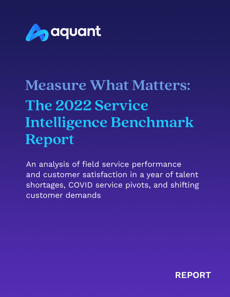
This feature is just one short excerpt from a report published by Aquant
www.fieldservicenews.com subscribers can read the full report now by hitting the button below.
If you are yet to subscribe you can do so for free by hitting the button and registering for our complimentary subscription tier FSN Standard on a dedicated page that provides you instant access to this white paper PLUS you will also be able to access our monthly selection of premium resources as soo as you are registered.
 Data usage note: By accessing this content you consent to the contact details submitted when you registered as a subscriber to fieldservicenews.com to be shared with the listed sponsor of this premium content Aquant who may contact you for legitimate business reasons to discuss the content of this white paper, as per the terms and conditions of your subscription agreement which you opted into in line with GDPR regulations and is an ongoing condition of subscription.
Data usage note: By accessing this content you consent to the contact details submitted when you registered as a subscriber to fieldservicenews.com to be shared with the listed sponsor of this premium content Aquant who may contact you for legitimate business reasons to discuss the content of this white paper, as per the terms and conditions of your subscription agreement which you opted into in line with GDPR regulations and is an ongoing condition of subscription.
The Customer Experience Gap
The Customer Experience Gap shows the difference between what customers expect and what your organization delivers.
Our analysis shows that companies who measure FTF rates in 7-day or 14-day windows are setting the stage for a wide experience gap—which leads to frustrating customer experiences. The moral of the story: a few metrics can’t provide the entire picture. It’s time to look at experience as a whole.
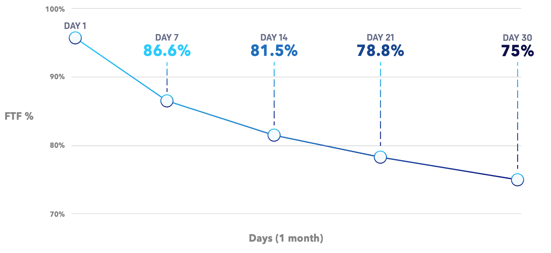
Instead of defining FTF in arbitrary time increments (7 days, 14 days, or 21 days), think about it in terms of the natural service cycle. Our research shows that measuring in 30-day windows strips out false-positive FTF rates.
Understand where your organization falls on the Customer Experience Gap chart.
- If your FTF rate is similar when measured at 7 days and 30 days, you have a small gap.
- If your FTF rate has a wide variation (usually a high rate at 7 days and a low rate at 30 days), you have a large gap.
- If you have a large gap, your team is focused on hitting their numbers instead of focusing on great customer experiences.
Why FTF Rates Vary by Time
When measured in short windows (like 7-day increments), jobs where a technician made an incorrect fix—but got the machine to work temporarily—will be marked as complete. But an incorrect fix is only a temporary measure, and the machine will continue to break down until properly repaired. For instance, a customer may call for service two or three times in a 30-day window. If you only measure in 7-day increments, your dashboard may show you successfully completed three jobs for one customer. In reality, these were three failed visits. This environment also leads to customer escalations and customer complaints that management may deem as “surprise complaints” that they didn’t see coming.
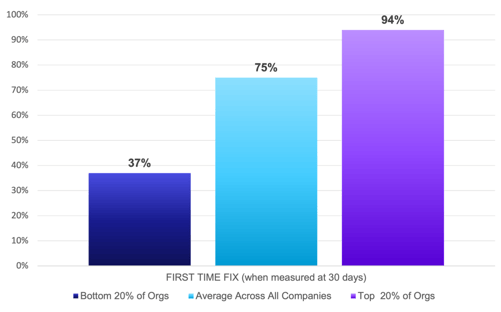
When it comes to service, it’s just as important to maximize the time between events and failures as it is to fix things correctly the first time. The less a customer needs a technician on-site, the better. This means the customer’s needs are being met.
Two Examples of Poor Customer Experiences
Company A: KPIs are not aligned to customer outcomes
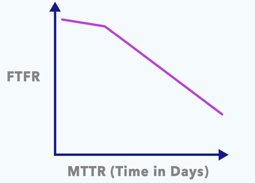
When FTF curves start out flat, it means that the company likely incentivizes high FTF rates over deep problem-solving. That’s shown by the curve getting steeper at the end of a 30-day cycle, indicating that the FTF rate is plummeting.
The key takeaway: Company A is not closely monitoring FTF rate—or there is no incentive to maintain a high rate over a long period of time—leading to poor customer experiences.
Company B: KPIs are not aligned to customer outcomes
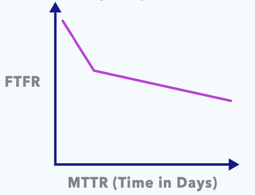
Here, the FTF rate starts out high and eventually flattens out. This may indicate that more preparation, information, or triage was needed before visiting a job site. A return visit would most likely be required to successfully solve the problem. Unlike Company A, Company B eventually solves root problems, but it requires several visits.
The key takeaway: Company B is trying to provide great customer service, but has some limitations that hinder quick and accurate outcomes, such as a lack of prep or an employee knowledge gap.
The Skills Gap - A Profile of the Top and Lowest Performing Organisations
What does the knowledge gap have to do with hitting KPIs?
If there is a large knowledge gap between team members, performance will vary—and so will customers’ experiences. That’s why it’s crucial to make sure that your technicians are equally knowledgeable about the equipment that they service and up-to-date on specific customer preferences.
Determine your team’s skills gap.
To increase your team’s knowledge and success, you must first identify how much of a gap exists between your star technicians (heroes) and underperformers (challengers).
For this report, we calculated the percentage difference between heroes and challengers across all organizations on the following page. We divided it into:
- Above average organizations
- Above performing organizations
- Below average organizations
A Snapshot of high performing and low performing organizations
The top 20% of organizations have a smaller workforce skills gap. A workforce with a more equal knowledge distribution results in more consistent customer experiences.
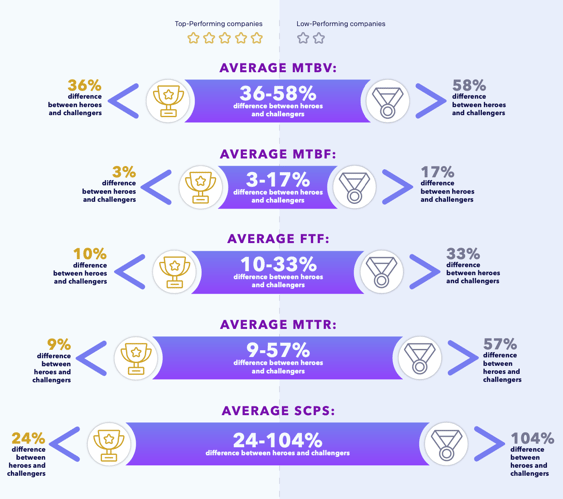
Why the Skills Gap Matters
A bigger distance between heroes and challengers leads to:
- Decrease in customer satisfaction
- Increased workload on your already overburned experts
- Increase in service costs
- Less capacity for organizational resilience
- Negative impact on growth
What's Next?
The service industry is facing unprecedented workforce shortages and increasing customer demands. A better way to overcome these challenges is to understand your business on a much deeper level than you do today so you can tailor service for every customer. Here’s where to start.

This feature is just one short excerpt from a report published by Aquant.
www.fieldservicenews.com subscribers can read the full report now by hitting the button below.
If you are yet to subscribe you can do so for free by hitting the button and registering for our complimentary subscription tier FSN Standard on a dedicated page that provides you instant access to this white paper PLUS you will also be able to access our monthly selection of premium resources as soo as you are registered.
 Data usage note: By accessing this content you consent to the contact details submitted when you registered as a subscriber to fieldservicenews.com to be shared with the listed sponsor of this premium content Aquant who may contact you for legitimate business reasons to discuss the content of this white paper, as per the terms and conditions of your subscription agreement which you opted into in line with GDPR regulations and is an ongoing condition of subscription.
Data usage note: By accessing this content you consent to the contact details submitted when you registered as a subscriber to fieldservicenews.com to be shared with the listed sponsor of this premium content Aquant who may contact you for legitimate business reasons to discuss the content of this white paper, as per the terms and conditions of your subscription agreement which you opted into in line with GDPR regulations and is an ongoing condition of subscription.
Further Reading:
- Read more about Aquant on Field Service News @ www.fieldservicenews.com/aquant
- Read more about Digital Transformation @ www.fieldservicenews.com/digital-transformation
- Read more about Leadership & Strategy @ www.fieldservicenews.com//leadership-and-strategy
- Learn more about Aquant @ www.aquant.io
- Follow Aquant on Twitter @ twitter.com/Aquant_io
Nov 24, 2021 • Features • connectivity • Digital Transformation • GLOBAL • TELENOR CONNEXION • LTE-M • NB-IOT
In this second feature of a series of excerpts from a recent white paper published by Telenor Connexion, we look in-depth at the characteristics of LTE-M and NB-IoT technologies and how they will affect the market.
In this second feature of a series of excerpts from a recent white paper published by Telenor Connexion, we look in-depth at the characteristics of LTE-M and NB-IoT technologies and how they will affect the market.

This feature is just one short excerpt from a white paper published by Telenor Connexion.
www.fieldservicenews.com subscribers can read the full white paper now by hitting the button below.
If you are yet to subscribe you can do so for free by hitting the button and registering for our complimentary subscription tier FSN Standard on a dedicated page that provides you instant access to this white paper PLUS you will also be able to access our monthly selection of premium resources as soo as you are registered.

Data usage note: By accessing this content you consent to the contact details submitted when you registered as a subscriber to fieldservicenews.com to be shared with the listed sponsor of this premium content Telenor Connexion who may contact you for legitimate business reasons to discuss the content of this white paper, as per the terms and conditions of your subscription agreement which you opted into in line with GDPR regulations and is an ongoing condition of subscription.
LTE-M AND NB-IOT TECHNOLOGIES - INCREASED BATTERY LIFE, ENHANCED COVERAGE AND SIMPLIFIED HARDWARE
LTE-M and NB-IoT are designed to support IoT devices that need a long battery life or are used at locations that are difficult to reach with normal 4G technology, such as deep indoor locations.
So how are they different and how will they affect the market?

Battery Life and Increased Coverage
Battery life is increased by reducing the radio communications between device and network, and devices can go into sleep mode or listen less often to the network. LTE-M and NB-IoT both offer better coverage than 4G in, for example, deep indoor or remote areas.
There is however a trade-off between battery life, coverage and responsiveness. To leverage this requires access to new types of functionality in the network- for example PSM and EDRX use cases that need a fast response are less suitable for battery saving and enhanced coverage.
Likewise, devices that need a life cycle of 10 years need to be deployed in areas with good coverage. To support a balanced approach, battery saving and enhanced coverage are applied in step with each other. Significant improvement in battery life and coverage can be achieved by sleep mode and applying the right level of repetitions.
New Pricing Models Likely to Emerge
Pricing models for LTE-M and NB-IoT will likely be different to traditional telecom pricing because of the different traffic profile involved with IoT connectivity. There will be a vast number of connected LTE-M and NB-IoT devices but they will send low amounts of data. Rather than the data consumption per device price model, network providers will most likely consider charging access fees for devices on a per device basis for LTE-M and NB-IoT, or a combination of both, to better match the network resources consumed by these devices.
Hardware Simplification
LTE-M and NB-IoT both use simplified versions of regular 4G which reduces hardware complexity and cost once the technology is operating at scale.
GSMA maintains a list of modules that are commercially available at: https://www.gsma.com/ iot/mobile-iot-modules/ showing that the market for modules is fragmented into three main categories: modules supporting either LTE-M or NB-IoT and modules that support both LTE-M and NB-IoT.
LTE-M AND NB-IOT - GLOBAL AVAILABILITY AND OUTLOOK
Moving towards local availability in all countries
For global deployments of devices, enterprises need to take the life cycle of technology in consideration.
Global deployments need global availability, but new technologies are first locally available, typically in urban areas or with nationwide deployments. So when can we expect global availability for LTE-M and NB-IOT?
Today, the status for LTE-M and NB-IoT is that they are both locally available and on their way to becoming globally available.
We see that sometimes one operator in a region starts focusing on either LTE-M or NB-IoT, after which their competitors in the same region often offers the alternative.
We expect that in a few years both LTE-M and NB-IoT will be locally available in all countries.
Nationwide deployments are a good start but for global availability, commercial global roaming agreements between operators must be in place, so enterprises can deploy their devices using only one contract and one point of contact.
With 4G widely available and 5G around the corner, 2G and 3G are slowly being phased out. 2G technology is today still widely used in IoT solutions. 2G voice technology is used for voice calling, including emergency calls such as eCall - a European initiative for rapid assistance to motorists involved in a collision anywhere in the European Union. eCall was made mandatory in all new type-approved cars sold in the European Union from April 2018. As eCall mandates 2G voice, operators in the European Union cannot simply phase out 2G.
We expect that most European operators will support 2G until 2025. In North America, 2G is less widely available and certain countries in Asia and the Pacific have already phased out 2G.
LTE-M and NB-IoT are starting to become globally available, starting with LTE-M. We expect LTE-M and NB-IoT to be available during the complete lifecycle of 5G.

This feature is just one short excerpt from a white paper published by Telenor Connexion.
www.fieldservicenews.com subscribers can read the full white paper now by hitting the button below.
If you are yet to subscribe you can do so for free by hitting the button and registering for our complimentary subscription tier FSN Standard on a dedicated page that provides you instant access to this white paper PLUS you will also be able to access our monthly selection of premium resources as soo as you are registered.
 Data usage note: By accessing this content you consent to the contact details submitted when you registered as a subscriber to fieldservicenews.com to be shared with the listed sponsor of this premium content Telenor Connexion who may contact you for legitimate business reasons to discuss the content of this white paper, as per the terms and conditions of your subscription agreement which you opted into in line with GDPR regulations and is an ongoing condition of subscription.
Data usage note: By accessing this content you consent to the contact details submitted when you registered as a subscriber to fieldservicenews.com to be shared with the listed sponsor of this premium content Telenor Connexion who may contact you for legitimate business reasons to discuss the content of this white paper, as per the terms and conditions of your subscription agreement which you opted into in line with GDPR regulations and is an ongoing condition of subscription.
Further Reading:
- Read more about Digital Transformation @ www.fieldservicenews.com/digital-transformation
- Read more about Mobile Connectivity @ www.fieldservicenews.com/connectivity
- Read more about Telenor on Field Service News @ www.fieldservicenews.com/telenor
- Learn more about Telenor Connexion @ www.telenorconnexion.com
- Follow Telenor Connexion on Twitter @ twitter.com/t_connexion
- Connect with Telenor Connexion on LinkedIn @ www.linkedin.com/telenor-connexion-ab/
Nov 22, 2021 • Features • Digital Transformation • servicemax • Daniel Brabec • GLOBAL
In this article for Field Service News, Daniel Brebac, Director of Global Customer Transformation at ServiceMax, discusses why many service organizations are struggling to fill the gaps in their workforce right now and how they can improve their...
In this article for Field Service News, Daniel Brebac, Director of Global Customer Transformation at ServiceMax, discusses why many service organizations are struggling to fill the gaps in their workforce right now and how they can improve their recruiting strategy.
A couple of years ago I was at a Field Service conference, engaged in the round robin style networking chats that we all know so well. Those are generally an opportunity for the companies that sponsor the show to chat with the individuals that attend. You have some nice banter about what the company or individual does, then you go on your way. On this occasion, two conversations stuck in my memory. One because I found it fascinating how their organization was attempting to turn the plant-based beverage market on its head, and the other because they seemed to have solved one of the largest issues that has plagued many asset service management companies – discovering the future of service techs.
For as long as I have been involved in service, my experience has led to a few truths:
#1 - Proactive maintenance is beneficial only if you are collecting and analyzing actionable data
#2 - Tracking parts can lead to one of the largest bottom-line savings in the service organization
#3 - Most service companies are still wrestling with how to counter the silver tsunami and attract the next generation of service talent to their organization
When trying to recruit more people to the abundance of career opportunities that exist in service, it helps to know what is important to your audience. I am reminded of a quote by Tracee Ellis Ross: “I am learning every day to allow the space between where I am and where I want to be, to inspire me and not terrify me.” The company that solved the issue around the future of service techs understood this. The Vice President that I spoke with had a connection to the local high schools and started his recruiting there. They shared the vision for where their target audience wanted to be in life, and how they could help get them there. As they joined the organization, these young adults received training, benefits, and were well compensated for the work that they did. Additionally, the company made sure to do annual resume reviews with the service techs, where they would help them to spruce up their resume to ensure they were prepared to take the next step in their journey if they wanted to look for growth opportunities in the future.
Let’s go back to the points of importance, because I don’t want anyone to miss the key takeaways when building their new recruiting strategy.
#1 – Compensation and Benefits
Let’s get down to brass tacks here – if a tech can make more money going somewhere else, or doing something else, there is a good chance they will leave. You must ensure that your compensation package is competitive in the market. Do your market research. I once spoke with a group of techs that jumped back and forth between companies for incremental raises.The companies spent more money on recruiting the service engineers back, than if they had just given them a raise in the first place!#2 – Career Path
Many would assume that helping an employee with their resume will cause them to leave. In working with an employee on this, the company is demonstrating a couple things: they are committed to your growth as an individual, and they are recognizing your continued increased value over the years you’ve invested. Perhaps the tech doesn’t realize that they now have senior level experience on XYZ machine, and that qualifies them to spend some time training the new hires, instead of in the field. For techs with young families, this can be a huge benefit. Many techs spend a lot of time on the road, and the ability to spend a little more time at home with their family can lead to increased levels of employee satisfaction and retention. Expanding on that idea a little further, organizations must realize that there is not a singular path to becoming a valued part of the service team; multiple paths with varied career growth options is a must.#3 – Emerging Technology
Generations that have grown up with the internet and cell phones in their hands have an expectation of utilization of technology to simplify their work. Many service organizations and solution providers have begun implementing Artificial Intelligence (AI) and Augmented Reality (AR) solutions into their service organization. Knowing they will be able to utilize future technologies in their workplace is exciting, has the benefit of making their job easier, and gets your techs in the field independently at a faster pace. If they have an issue with an asset, and a senior tech is available to coach them while working on the piece of equipment, the job is done quicker, the first time, and the need to return is reduced.Many organizations are struggling to fill the gaps in their workforce right now; but the service industry has the distinct advantage in that it can provide on the job training, a shorter onboarding time, future careers opportunities, and strong compensation. Showcasing these strengths and understanding who you are trying to recruit will position your business for continued growth well into the future.
Further Reading:
- Read more about Leadership and Strategy @ www.fieldservicenews.com/leadership-strategy
- Read news and articles about ServiceMax @ www.fieldservicenews.com/servicemax
- Find out more about ServiceMax @ www.servicemax.com/uk
- Connect with Daniel Brebac on LinkedIn @ www.linkedin.com/danielbrabec/
- Follow ServiceMax on Twitter @ twitter.com/ServiceMax
Nov 22, 2021 • News • Augmented Reality • Remote Assistance • Digital Transformation • FieldBit • Help Lightning • EMEA
Help Lightning, the leading provider of remote visual assistance software, announced today the acquisition of Fieldbit, an augmented reality-enabled platform known for its innovative knowledge sharing, remote collaboration and workflow automation...
Help Lightning, the leading provider of remote visual assistance software, announced today the acquisition of Fieldbit, an augmented reality-enabled platform known for its innovative knowledge sharing, remote collaboration and workflow automation capabilities supporting both expert led and self-help solutioning.
Help Lightning is a leading innovator in the application of augmented reality for use cases that deliver positive outcomes in industries such as complex medical equipment and telecommunications. According to Gartner®, “by 2026, 75% of capital-equipment-intensive industries will use AR as a key component for cost reduction/avoidance among frontline workers”. With significant category growth expected over the next 3 years, the acquisition of Fieldbit will provide the broadest and deepest value creation for its growing list of global enterprise customers.
THE ACQUISITION SIGNIFICANTLY ENHANCES HELP LIGHTNING'S INDUSTRY-LEADING REMOTE ASSISTANCE SOLUTION WITH NEW, EXPANSIVE CAPABILITIES TO DEEPEN CUSTOMER VALUE
“Today’s announcement represents another exciting milestone for Help Lightning and more good news for our more than 200 customers who benefit every day from our AR-enabled solution,” said Gary York, CEO of Help Lightning. “The acquisition of Fieldbit is an important step in fulfilling our vision to provide instant access to expertise, delivering dramatic improvements in first time fix rates, resolution times, and customer satisfaction.”With Fieldbit, Help Lightning customers will benefit from access to additional capabilities to enable real-time, expert-led problem solving while also supporting a variety of self-help scenarios. The combined solution will include an industry-leading set of capabilities such as:
- Remote video collaboration and technical support
- 3D annotation
- The industry’s only Merged Reality feature
- Knowledge capture and share
- Work instructions including operational & safety procedures
- Augmenting real time data from IIoT platforms
With this acquisition, Help Lightning improves support for the ever-expanding needs of enterprise customers who depend on its services, including leading brands like Ricoh, Bunn and Becton Dickinson. Fieldbit brings depth and breadth in comparison to other solutions on the market, allowing the combined power of these two industry leaders to successfully meet the needs of today’s global enterprises. Fieldbit has a strong roster of successful customers including large enterprises such as BP, Emerson, and Veolia.
“From the beginning, our vision at Fieldbit has been to be at the forefront of technology so we can provide the most advanced AR solutions for our customers,” said Evyatar Meiron, CEO of Fieldbit. “With our strong footprint in the energy, utilities and manufacturing industries, and together with Help Lightning’s ability to create and expand customer value, we are now able to bring unparalleled expertise and powerful capabilities to create positive outcomes for our customers.”For more information about how Help Lightning enables business experts to virtually work side-by-side with anyone needing help, anywhere in the world, visit helplightning.com.
Further Reading:
- Read more about Digital Transformation @ www.fieldservicenews.com/digital-transformation
- Read more about Help Lightning on Field Service News @ www.fieldservicenews.com/helplightning
- Read more about Remote Assistance on Field Service News @ www.fieldservicenews.com/remote-assistance
- Find out more about Help Lightning @ helplightning.com
- Learn more about Fieldbit @ www.fieldbit.net
- Connect with Help Lightning on LinkedIn@ www.linkedin.com/company/helplightning/
- Follow Help Lightning on Twitter @ twitter.com/helplightning
Nov 18, 2021 • News • Digital Transformation • healthcare • servicemax • EMEA • FUJIFILM
ServiceMax, Inc., a leader in asset-centric field service management, has announced that FUJIFILM Healthcare Europe has selected and deployed ServiceMax’s field service management platform for the digitization of its service operations in Europe.
ServiceMax, Inc., a leader in asset-centric field service management, has announced that FUJIFILM Healthcare Europe has selected and deployed ServiceMax’s field service management platform for the digitization of its service operations in Europe. As part of its move from a product-focused services strategy to outcome-based solutions, ServiceMax is empowering FUJIFILM Healthcare Europe to better support hospitals and other medical providers with more personalized solutions and service maintenance as they continue the expansion of treatment and diagnostic capabilities available to patients.
SERVICEMAX DRIVING OPERATIONAL EXCELLENCE, EFFICIENCY AND DIGITAL MONITORING OF KPIs
“By digitizing its service operations, FUJIFILM Healthcare Europe will drive operational excellence through optimised processes, delivering greater customer and employee satisfaction and more efficient service planning.
“We already had plans to move our service technicians away from pen and paper, but COVID-19 forced us to rethink healthcare and connect digitally,” said Jean-Luc Budillon, President and COO at FUJIFILM Healthcare Europe. “Our vision is to become a leading healthcare company with excellent customer experience and innovative solutions. With our shift to outcome-based solutions, the ServiceMax platform ensures we will always be able to provide timely and personalized assistance to our engineers whilst still being able to prioritize individual relationships and commitments with our customers. We are a passionate team going the extra mile for our customers, and ServiceMax is the right partner to help us take service care to the next level.”
By completely digitizing its technical service support process, FUJIFILM Healthcare Europe has instant and easy access to critical customer information, such as machines installed, contract details and warranty duration, as well as specific parts. The company can now optimize service planning and improve the management of spare parts, and ultimately provide a better customer experience.
“With ServiceMax, we can plan resources more efficiently and provide faster and more proactive customer support with all the necessary information directly available, enabling our engineers to take immediate decisions,” added Robbert Merkus, Head of Services Europe at FUJIFILM Healthcare Europe. “ServiceMax also simplifies our review process with dashboard monitoring and management of all KPIs for our outcome-based solutions.”
ServiceMax was deployed in Italy in November 2020 and is currently rolling out across Belgium, the Netherlands, Spain, UK, DACH and France.
Further Reading:
- Read more about Digital Transformation @ www.fieldservicenews.com/digital-transformation
- Read more about ServiceMax on Field Service News @ www.fieldservicenews.com/servicemax
- Read more about Healthcare on Field Service News @ www.fieldservicenews.com/healthcare
- Find out more about ServiceMax @ www.servicemax.com
- Learn more about FujiFilm Healthcare Europe @ hce.fujifilm.com
- Follow ServiceMax on Twitter @ twitter.com/ServiceMax
Nov 18, 2021 • Features • Digital Transformation • Aquant • Covid-19 • customer experience
Aquant, has recently published the 2022 Service Intelligence Benchmark Report, now available at Field Service News, which offers an in-depth analysis of field service performance and customer satisfaction in a year of talent shortage, COVID service...
Aquant, has recently published the 2022 Service Intelligence Benchmark Report, now available at Field Service News, which offers an in-depth analysis of field service performance and customer satisfaction in a year of talent shortage, COVID service pivots, and shifting customer demands. In this excerpt from the report, we look at what KPIs do and don't tell us.

This feature is just one short excerpt from a report published by Aquant
www.fieldservicenews.com subscribers can read the full report now by hitting the button below.
If you are yet to subscribe you can do so for free by hitting the button and registering for our complimentary subscription tier FSN Standard on a dedicated page that provides you instant access to this white paper PLUS you will also be able to access our monthly selection of premium resources as soo as you are registered.
 Data usage note: By accessing this content you consent to the contact details submitted when you registered as a subscriber to fieldservicenews.com to be shared with the listed sponsor of this premium content Aquant who may contact you for legitimate business reasons to discuss the content of this white paper, as per the terms and conditions of your subscription agreement which you opted into in line with GDPR regulations and is an ongoing condition of subscription.
Data usage note: By accessing this content you consent to the contact details submitted when you registered as a subscriber to fieldservicenews.com to be shared with the listed sponsor of this premium content Aquant who may contact you for legitimate business reasons to discuss the content of this white paper, as per the terms and conditions of your subscription agreement which you opted into in line with GDPR regulations and is an ongoing condition of subscription.
WHAT KPI MEASUREMENTS DO AND DON'T TELL US
KPIs don't equal customer sentiment
In the Service Leader’s Guide to Workforce KPIs, we examined why workforce measurement is more critical than ever, and we defined best practices for measurement criteria.
For the 2022 Service Intelligence Benchmark Report, we went a step further. We analyzed service data to understand service performance beyond KPI measurement. We found that knowing your KPIs—by number or average performance—is not the same as understanding what those numbers reveal about customer satisfaction, employee skill level, or overall service performance. Averages don’t disclose the specific details you need to make critical service decisions.
Service KPIs by the numbers
Here’s the breakdown of how service organizations measure up against other organizations and the industry as a whole.
FTFR - First Time Fix Rate
What is it?
First Time Fix rate is one of the most popular metrics for workforce measurement. It indicates how often someone is able to fix an issue on the first try. In this report, we are measuring the FTF rate of field visits, in a 30-day window.

Key Observation:
FTF rates have hovered around 75% for more than a decade—and remained stagnant for all but a handful of top-performing companies. Additionally, FTF rates should never be measured in isolation. On average, a failed first visit leads to 2.5 additional visits and 20 days for MTTR.
CPS - Cost Per Success
What is it?
The total amount required to successfully close a service ticket is known as the Cost Per Success (CPS). This is a bit different from other similar-sounding KPIs, such as Cost Per Truck Roll, since total CPS may include multiple visits, multiple truck rolls, a variety of parts, and other labor costs.
Some organizations may measure Cost Per Work Order, but that metric leaves out cases that include always assigning experts to the most complex (and expensive) jobs. Additionally, it does not account for cases where multiple work orders are related to the same core issue.
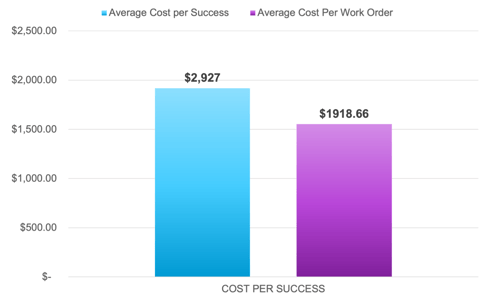
Key Observation:
Successfully resolving an issue involves nearly 42% more in costs versus looking at work orders individually. While average costs are dependent on the company and type of equipment being serviced, the cost difference is the most important to keep in mind.
MTTR - Mean Time to Resolution
What is it?
The Mean Time to Resolution KPI measures the time it takes to resolve a customer issue. Typically, it’s the time between the case creation date and the closure date. Similar to the pain of staying on hold when trying to resolve a personal issue, minimizing MTTR is a key factor in increasing positive customer experiences and reducing service costs. In the last year, we’ve seen a growing divide in this metric.
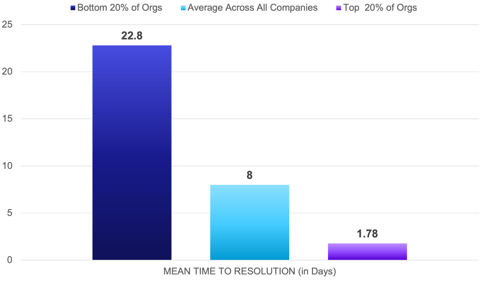
MTTR (in days):
• 8 days: average across all companies• 1.78 days: top 20% of organizations• 22.8 days: bottom 20% of organizations
MTBF - Mean Time Between Failures
What is it?
Mean Time Between Failures quantifies the average time between customer issues. Service organizations try to maximize this metric because a higher rate represents excellent service quality and maximum uptime.
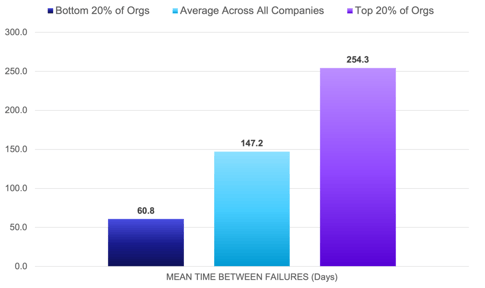
• 139.9 days: Average across all companies (147.2 in 2021)
• 231.8 days: Top 20% of organizations (254.3 in 2021)
• 57.5 days: Bottom 20% of organizations (60.8 in 2021)
Key Observation:
Individual pieces of equipment may have differing life cycles, but service leaders need to understand underlying patterns—in both their machines and workforces. When visiting a job site, experienced service heroes know how to use their time wisely and ensure that assets are working properly before leaving. This can significantly extend the time between failures.
MTBV - Mean Time Between Visits
What is it?
Need to calculate both uptime and service performance? Look no further than the Mean Time Between Visits metric. This measures every visit you have for an asset or customer, instead of only tracking time between failures.
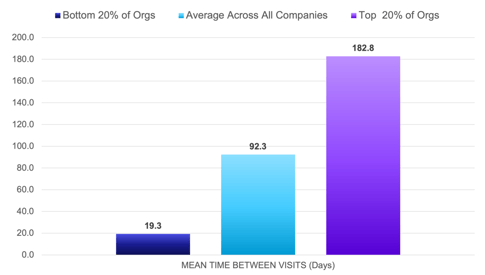
• 92.3 days: average across all companies
• 182.8 days: top 20% of organizations
<• 19.28 days: bottom 20% of organizations
Key Observation:
Experienced techs will skew towards longer time intervals between visits. That’s great news, thanks to low repeat visit rates, as well as their ability to utilize every visit to maximize uptime.

This feature is just one short excerpt from a report published by Aquant.
www.fieldservicenews.com subscribers can read the full report now by hitting the button below.
If you are yet to subscribe you can do so for free by hitting the button and registering for our complimentary subscription tier FSN Standard on a dedicated page that provides you instant access to this white paper PLUS you will also be able to access our monthly selection of premium resources as soo as you are registered.
 Data usage note: By accessing this content you consent to the contact details submitted when you registered as a subscriber to fieldservicenews.com to be shared with the listed sponsor of this premium content Aquant who may contact you for legitimate business reasons to discuss the content of this white paper, as per the terms and conditions of your subscription agreement which you opted into in line with GDPR regulations and is an ongoing condition of subscription.
Data usage note: By accessing this content you consent to the contact details submitted when you registered as a subscriber to fieldservicenews.com to be shared with the listed sponsor of this premium content Aquant who may contact you for legitimate business reasons to discuss the content of this white paper, as per the terms and conditions of your subscription agreement which you opted into in line with GDPR regulations and is an ongoing condition of subscription.
Further Reading:
- Read more about Aquant on Field Service News @ www.fieldservicenews.com/aquant
- Read more about Digital Transformation @ www.fieldservicenews.com/digital-transformation
- Read more about Leadership & Strategy @ www.fieldservicenews.com//leadership-and-strategy
- Learn more about Aquant @ www.aquant.io
- Follow Aquant on Twitter @ twitter.com/Aquant_io
Nov 17, 2021 • Features • connectivity • Digital Transformation • GLOBAL • TELENOR CONNEXION • LTE-M • NB-IOT
In the first feature of a series of excerpts from a recent white paper published by Telenor Connexion, we look at the development and evoliution of mobile connectivity technologies.
In the first feature of a series of excerpts from a recent white paper published by Telenor Connexion, we look at the development and evoliution of mobile connectivity technologies.

This feature is just one short excerpt from a white paper published by Telenor Connexion.
www.fieldservicenews.com subscribers can read the full white paper now by hitting the button below.
If you are yet to subscribe you can do so for free by hitting the button and registering for our complimentary subscription tier FSN Standard on a dedicated page that provides you instant access to this white paper PLUS you will also be able to access our monthly selection of premium resources as soo as you are registered.

Data usage note: By accessing this content you consent to the contact details submitted when you registered as a subscriber to fieldservicenews.com to be shared with the listed sponsor of this premium content Telenor Connexion who may contact you for legitimate business reasons to discuss the content of this white paper, as per the terms and conditions of your subscription agreement which you opted into in line with GDPR regulations and is an ongoing condition of subscription.
Connectivity is a crucial part of product design and performance and the choice of connectivity technology must be considered early in the process. This is a challenging choice given the quick technology and market development. 5G technologies are around the corner, 2G and 3G networks are starting to be phased out and new network technologies that support LPWAN are starting to become globally available in the form of LTE-M and NB-IoT- also referred to as Mobile IoT.
For the first time networks have been developed to answer to the specific needs of connecting things. Previously, connected units have been communicating on infrastructure developed for consumer needs.
LTE-M and NB-IoT are standardized, secure, and operator-managed in licensed spectrum. They are designed for IoT applications that are low cost, use low data rates, require long battery lives and often operate in locations that are hard to reach.
LTE-M and NB-IoT will be the obvious choices for industries looking for 2G and 3G replacements for devices with long lifecycles, requiring extended device battery life and coverage.
Both technologies are good choices for deployments with expected lifespans of a decade or more, however there are differences between them which make each of them more suitable for some IoT applications rather than others.
So which one is the best choice for your application?
This guide describes the relative benefits and limitations of each technology to help enterprises to make the right selection for long-term success.

Here's a short overview of the development of mobile connectivity technologies. Mobile connectivity has evolved from being the infrastructure for human communication to telemetry, machine-to-machine and the internet of things applications.
-
The first version of mobile connectivity – 1G – introduced wireless voice.
-
In 2G, roaming and SMS messaging were introduced and were later enhanced with GPRS for data communication. SMS messaging and GPRS became widely used for basic telemetry. Roaming made mobile technology suitable for deployments in multiple countries. Telenor was one of the first operators to offer M2M communications with things connected over the 2G network as early as the 1990s.
-
3G became a truly global standard and combined the best of competing technologies in a single standard. 3G evolutions were mainly centered around high speed data applications.
-
4G introduced LTE technology used for devices constantly connected to the internet. 4G answered the consumer need for bandwidth and speed and introduced a new way to handle voice, replacing 2G voice.
-
LTE-M and NB-IoT (Mobile IoT) are especially designed for the Internet of Things. LTE-M and NB-IoT support devices that need a long battery life and devices that need good network access in areas that are difficult to reach.
- 5G networks use a combination of existing 4G LTE and new 5G New Radio (5G NR) technology. 4G and 5G have been designed to co-exist and applications designed for 4G, including LTE-M and NB-IoT, can be expected to have a very long life. Today most networks that claim to be 5G networks are in fact using 4G LTE.
- 5G enhances 4G in three main use case areas; enhanced mobile broadband, critical communications and mobile IoT.
-
Enhanced mobile broadband is currently targeted towards consumers that need ever-increasing bandwidth. It also enables new IoT use cases that require high data volumes, for example streaming video.
-
Critical communications demands a much faster response and increased quality of service and security. 5G introduces 5G New Radio Technology which uses a higher radio frequency.
-
Mobile IoT - LTE-M and NB-IoT - are forward compatible with the 5G NR technology, which means that LTE-M and NB-IoT technology can be used throughout the complete 5G life cycle.

This feature is just one short excerpt from a white paper published by Telenor Connexion.
www.fieldservicenews.com subscribers can read the full white paper now by hitting the button below.
If you are yet to subscribe you can do so for free by hitting the button and registering for our complimentary subscription tier FSN Standard on a dedicated page that provides you instant access to this white paper PLUS you will also be able to access our monthly selection of premium resources as soo as you are registered.
 Data usage note: By accessing this content you consent to the contact details submitted when you registered as a subscriber to fieldservicenews.com to be shared with the listed sponsor of this premium content Telenor Connexion who may contact you for legitimate business reasons to discuss the content of this white paper, as per the terms and conditions of your subscription agreement which you opted into in line with GDPR regulations and is an ongoing condition of subscription.
Data usage note: By accessing this content you consent to the contact details submitted when you registered as a subscriber to fieldservicenews.com to be shared with the listed sponsor of this premium content Telenor Connexion who may contact you for legitimate business reasons to discuss the content of this white paper, as per the terms and conditions of your subscription agreement which you opted into in line with GDPR regulations and is an ongoing condition of subscription.
Further Reading:
- Read more about Digital Transformation @ www.fieldservicenews.com/digital-transformation
- Read more about Mobile Connectivity @ www.fieldservicenews.com/connectivity
- Read more about Telenor on Field Service News @ www.fieldservicenews.com/telenor
- Learn more about Telenor Connexion @ www.telenorconnexion.com
- Follow Telenor Connexion on Twitter @ twitter.com/t_connexion
- Connect with Telenor Connexion on LinkedIn @ www.linkedin.com/telenor-connexion-ab/










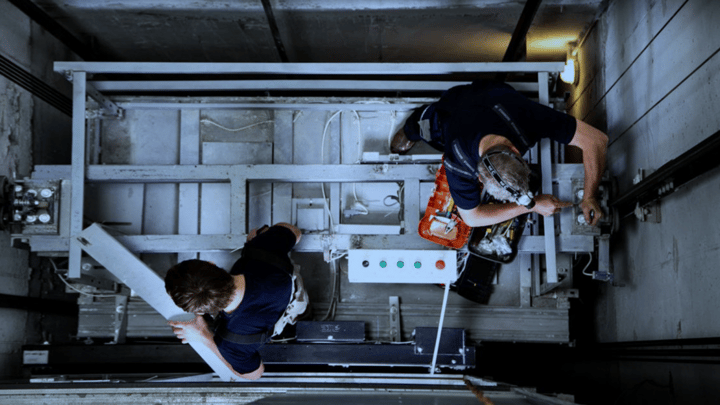








 Field Service News is published by 1927 Media Ltd, an independent publisher whose sole focus is on the field service sector. As such our entire resources are focused on helping drive the field service sector forwards and aiming to best serve our industry through honest, incisive and innovative media coverage of the global field service sector.
Field Service News is published by 1927 Media Ltd, an independent publisher whose sole focus is on the field service sector. As such our entire resources are focused on helping drive the field service sector forwards and aiming to best serve our industry through honest, incisive and innovative media coverage of the global field service sector.
Leave a Reply